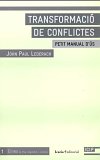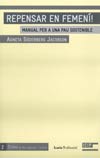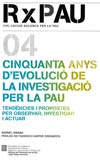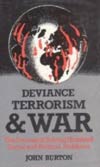Recommendations
More recommendations
-

Conflict transformation
John Paul Lederach. Transformació de conflictes: petit manual d'ús. Barcelona: Institut Català Internacional per la Pau; Icària, 2010
John Paul Lederach condenses much of his thought into this book, and explains why it is often more useful to transform conflicts by means of a constructive change rather than solving them in the short term. This conceptual framework is a milestone in the way we consider the construction of peace, and is therefore worth studying. From this perspective, conflict is inevitable and this is something that is very positive, because it gives us the opportunity to change. And to create a better situation than the one that previously existed.
According to Lederach's advice, we should become accustomed to considering today's problems as a window, and therefore looking to see what is on the other side, especially in the long term. The author is not naive, and is well aware that the world in which we live is highly complex. However, his approach consists of taking advantage of the benefits of these complexities, and the existence of the many choices that this implies, which are not necessarily mutually incompatible, while respecting everyone's feelings of identity. Although all this may seem a very dense subject matter, this is no longer the case in the final chapter, in which the author applies his theory to a real case, a controversy based on the role of the police in Colorado, the North American state where Lederach lives.
To find out which option to choose, the author asks us to consider the context carefully, and to ask ourselves a number of questions and to rethink a number of issues. This is the only way in which we will be able to use the transforming potential of conflict at all levels, ranging from those linked to the individual to the future of historic change, in which according to Lederach, patterns of violence and coercion will be replaced by social capacity for dialogue and non-violent systems guaranteeing human security and social change.
J.A.
-

Rethink!
Agneta Söderberg Jacobson. Repensar en femení!: manual per a una pau sostenible. Barcelona: Institut Català Internacional per la Pau; Icària, 2010
The ICIP has decided to begin its collection of tools for peace, security and justice with two useful books: Transformació de conflictes, by John Paul Lederach and Repensar en femení! by Agneta Söderberg Jacobson. Both books are short and clear manuals that provide the reader with specific resources. The first should be compulsory reading for everyone who works in this field. The second also includes the gender perspective, which is becoming increasingly influential in conflict resolution theory and in practice.
Agneta Söderberg explains it and gives many examples from Bosnia-Herzegovina, Cambodia, Liberia, Israel-Palestine, Macedonia, Guatemala, Serbia and Montenegro, Rwanda, East Timor, Somalia and the International Criminal Court. In all these cases, the participation of women in peace processes has had a positive influence on the evolution of these conflicts. This is true to such an extent that she concludes that it is a requirement for sustainable development. At this point, the book makes a qualitative leap in terms of theory, by suggesting a holistic model for the construction of peace in which gender equality plays a key role in all phases: during the war and conflict, during the peace negotiations and during the post-war reconstruction process.
As well as the recommendations based on this proposal, which form the core of the book, readers also have the opportunity to learn from the examples of good cooperation practices between civil society in the South and North (often in Scandinavian countries) which are always focused on strengthening the organisations in the South so that they can play an active role in development and conflict transformation. The links between civil national and international society are therefore present in this book, which ends with a positive and optimistic thought: if we succeed in including women in all stages of the peace process, the ideal of a just and egalitarian world will no longer only be a dream.
J.A.
-

Fifty years of progress in research for peace: trends and proposals for observation, research and action
Rafael Grasa. Cinquanta anys d'evolució de la investigació per la pau: tendències i propostes per observar, investigar i actuar. Barcelona: Oficina de Promoció de la Pau i dels Drets Humans, 2010. Col·lecció Recerca per la Pau, 4.
All scientific disciplines are liable to revision and the construction of their own historiography. However, in the case of research for peace, this review is even more necessary due to the fact that it is unprecedented. This study is a real manual for the discipline. The first section is a "bird's eye view," in the words of the author, of the discipline over the last fifty years. The second section is divided two subsections: the first focuses on the origins and causes of the birth for research into peace, reviewing its philosophical predecessors; and the second establishes the factors involved in this research. The third major section brings the topic up to date and provides keys for understanding and research in the post-cold war period. The final section contains the conclusions. The volume is accompanied by very useful appendices, providing examples of the use of indicators and the establishment of observatories, as well as complementary information on ethnopolitical conflicts by other authors.
In conclusion, a wide variety of groups could use the book: from universities to activists in the movement or workers in organisations. The language used does not prevent more profound issues and more complex issues in the development of research into peace being covered. It is also a break with the collection's past, as starting with the next issue, it will be published by the ICIP. It would be difficult to choose a work that embodies this transition better.
P.A.
-

Zeitoun
Dave Eggers. Zeitoun. Barcelona: Mondadori, 2010
The second novel in the series that the North American writer Dave Eggers (born Boston, 1970), editor of the cult literary journals McSweeney's and The Believer, began in 2006 with What is the what, relating stories from contemporary history based on the testimony of a real protagonist, in novel form.
In What is the what, Eggers reconstructed the story of children lost after the Sudanese civil war, based on the personal experience of Valentino Achak Deng. In this second book, the main character is the Syrian Abdulrahman Zeitoun, the anonymous hero of Hurricane Katrina which afflicted New Orleans in 2005, who became a victim of the errors and prejudices of the anti-terrorist policy implemented in the USA after 9/11 and the Al-Qaeda-based hysteria.
Zeitoun is being published in Spanish after having received numerous prizes, including the American Book Award, the Robert F. Kennedy Distinguished Honor Award and the Muslim Public Affairs Council Media Award. Eggers succeeds in reconstructing dramatic stories without succumbing to sentimentality, and even includes touches of humour, in a combination of the historical context with the personal adventures of the protagonists. All the profits from these novels will go to non-profit making foundations.
C.C.
-
Democratic Republic of the Congo, 1993-2003
République démocratique du Congo, 1993-2003. Rapport du Projet Mapping concernant les violacions les plus graves des droits de l'homme et du droit international humanitaire commises entre mars 1993 et juin 2003 sur le territoire de la République démocratique du Congo. Haut-Commissariat des Nations Unies aux droits de l'homme. Nations Unies, 2010.
Available at: http://www.ohchr.org/fr/Countries/AfricaRegion/Pages/RDCProjetMapping.aspx
Without aiming to be the result of thorough judicial investigations, the report provides one of the most comprehensive descriptions of the violations of human rights and international humanitarian law committed in the Democratic Republic of the Congo between March 1993 and June 2003. Its 550 pages are based on 1,280 eyewitness accounts and 1,500 documents, and relate 617 violent incidents that took place in various regions in the Democratic Republic of the Congo, perpetrated by regular and irregular armed forces, both Congolese and foreign, which mainly affected the civilian population.
This United Nations report, which is the result of an investigation that began in 2005 and ended in 2009, has been eagerly awaited. Despite the first draft that was initially circulated in August 2010, it was not officially published until 1 October.
Without aiming to be the result of thorough judicial investigations, the report provides one of the most comprehensive descriptions of the violations of human rights and international humanitarian law committed in the Democratic Republic of the Congo between 1993 and 2003. Its 550 pages are based on 1,280 eyewitness accounts and 1,500 documents, and relate 617 violent incidents that took place in various regions in the Democratic Republic of the Congo, perpetrated by regular and irregular armed forces, both Congolese and foreign, which mainly affected the civilian population.
The vast majority of the human rights violations documented could be considered war crimes or crimes against humanity by the competent judicial authorities. While the report also refers to evidence of genocide against the Hutus in the Congo, it concludes that a comprehensive judicial investigation will be necessary in order for a competent tribunal to rule on this issue.
The report focuses particularly on violence against women, sexual violence, and violence against boys and girls. Meanwhile, the chapter on the exploitation of natural resources highlights the relationship between this exploitation and the prolongation of the armed conflict and human rights violations. The report also includes an assessment of the Congolese criminal justice system and presents options for transitional justice in the country.
The report was subject to severe criticism from countries including Uganda, Rwanda, Burundi and Angola, and has also been subject to comments on specific aspects from the Congolese government, despite the latter acknowledging its usefulness in general terms, and stressing that the details it provides on all the victims and are a reminder of their right to truth and redress.
S.P.
-

Deviance, Terrorism and War: The Process of Solving Unsolved Social and Political Problems
John Burton. Deviance, Terrorism and War: The Process of Solving Unsolved Social and Political Problems. Palgrave Macmillan, 1979.
John Burton, who died on 23 June 2010 aged 95 (see PIP issue PIP 4 http://www.icip-perlapau.cat/revista/numero-4-setembre-2010/ens-han-deixat-dues-persones-cabdals-de-la-investigacio-a-la-pau-elise-boulding-i-john-w-burton.htm) was a high-ranking Australian diplomat (as a member of the Curtin Labor Government of the 1940s, he designed much of Australian foreign policy towards Asia and the Pacific) and was also a unorthodox and influential academic in the field of international relations.
A brief review of two of his works us enables us to present part of his thought. The first, Deviance, Terrorism and War: The Process of Solving Unsolved Social and Political Problems (Oxford, Martin Robertson, 1979), is the work that made Burton one of the advocates of the theory of basic human needs. Burton, taking his inspiration from the work of Abraham Maslow and Paul Sites and their eight needs which if met would ensure "normal" human behaviour, considers the objective grounds for understanding the causes of conflicts, transcending local political and cultural differences. He said that it would thereby be possible to design processes for conflict resolution and for the analysis and resolution of conflicts as an autonomous discipline. His pioneering vision was subsequently adopted by many others. In specific terms, while criticising realism-based approaches, Burton believed that the main needs for understanding destructive social conflicts were identity, recognition, security and personal development. However, he subsequently emphasised the shortcomings of the modern state system for meeting the needs of identity as being a major source of contemporary ethnopolitical conflict.
A second book, with very strong links to the first, is Conflict: Resolution and Provention (New York, St. Martin Press, 1990), which provides a historical and theoretical overview of approaches to conflict resolution, with a special emphasis on the approach called "problem-solving" and above all on preventing violent conflicts, which he called "prevention," thereby inventing a neologism to avoid the connotations of containment - of mere management of behaviour - implied by the term prevention. The first part of the book is concerned with general questions, and in particular basic assumptions on human nature, the role of the theory of needs, the context of conflicts, and the focuses of traditional approaches. The second part, from chapter 7 onwards, examines the political context of conflicts and in particular the relations between authorities, the problems of legitimisation of authority and above all, the way to intervene constructively in conflicts, from a social to an international level. The third part, starting at chapter 12, looks at conflict resolution, and the fourth looks at prevention.
In the final chapters, he returns to a key point in his thought: resistance to the institutionalisation of a conflict provention system reflects a need to change the paradigm, the creation of an international political system centred on resolution and provention, a system that he describes (in chapter 2) and education, the main instrument for taking us towards it.
These two books therefore provide an overall focus on the thought and work of a leading light in peace research.R.G.